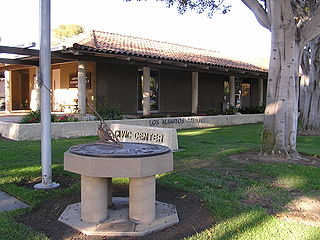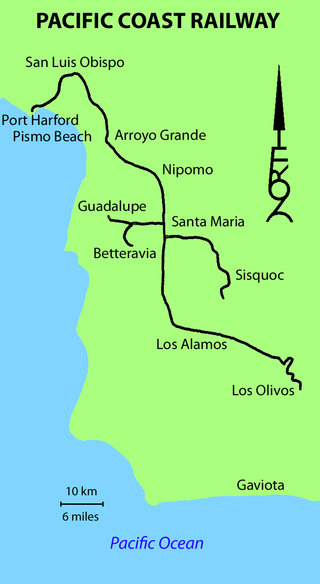

Betteravia (from French betterave "sugar beet roots") [1] was a community in northern Santa Barbara County, California on Betteravia Road, six miles west of Santa Maria.


Betteravia (from French betterave "sugar beet roots") [1] was a community in northern Santa Barbara County, California on Betteravia Road, six miles west of Santa Maria.
Betteravia was a company town founded on the former Rancho Punta de Laguna around the turn of the 20th century and existed for nearly ninety years. The Union Sugar Refining Company established a sugar beet farm here in 1897. [2] At one time this community supported a population of 350 residents, the vast majority of whom were employed by the Union Sugar Company, now a part of Sara Lee Corporation. The community consisted of 65 cottages, a hotel, a church, a schoolhouse, a post office, an amusement hall, a general store, a gasoline station, and a fire department. Housing consisted of small cottages, larger 2-3 bedroom homes, a larger superintendents home, and a very large plant managers home complete with fish ponds and an aviary. Housing was determined by plant seniority. It was common for employees to move to better housing within the community as they gained more responsibility in the plant.
The Pacific Coast Railway built an electrified line from Santa Maria to Betteravia in 1906. [3]
In the early 1960s, the Union Sugar Company decided it no longer wanted to maintain the increasingly old infrastructure of the community and gave notice to all residents to evacuate. The homes were sold for an average of $50 each. Most of the homes were bought by their renters and moved, and some were bought by other individuals. However, some residents remained until 1966 when the company closed the town and finally evicted the remaining residents.
On March 8, 1988, the sugar refinery plant, then owned by Imperial Holly (now known as Imperial Sugar), suffered a dust explosion and fire which resulted in the injury of eight employees, seven critically. Following the closure of Imperial Holly's Betteravia sugar plant here in 1993, Betteravia became a ghost town with many vacant and demolished buildings. [4] [5] [6]
On September 8, 2008, the Santa Maria Valley Railroad moved its corporate office and yard operations to the former Union Sugar site. The SMVRR had redeveloped the site and it is now the Betteravia Industrial Park, providing transload operations to rail freight customers not located on a rail line. Some of the buildings are being renovated, others and the old townsite is being preserved. The SMVRR has since moved its headquarters to 1599 'A' Street.
A former Union Sugar 0-4-0 Tender Saddle-Tank steam locomotive '1' is on Static display at the SMAT centre. The Tender is believed to have been scrapped for the war effort during World War II. The location is behind the old Hancock engine shops and is operated by the Santa Maria Valley Railway Historical Museum. Other displays include a Canadian National speeder, a former wooden Caboose, a Sacramento Northern Boxcar, and a signal, all on Static Display.

Fountain Valley is a suburban city in Orange County, California. The population was 57,047 at the 2020 census.

Hamilton City is a census-designated place (CDP) in Glenn County, California, United States. The population was 1,759 at the 2010 census, down from 1,903 at the 2000 census. Hamilton City is located 9.5 miles (15 km) east of Orland, and 10 miles west of Chico at an elevation of 151 feet. The community is inside area code 530. The default prefix used for wired telephones in the Hamilton City area is 826. The postal ZIP Code is 95951.

Los Alamitos is a city in Orange County, California. The city was incorporated in March 1960. The population was 11,780 at the 2020 census, up from 11,449 at the 2010 census. The adjacent unincorporated community of Rossmoor uses the same 90720 ZIP code in its mailing address, but is not part of the city. The Los Alamitos Race Course is named for the city, but lies in the neighboring city of Cypress.

Santa Maria is a city in the Central Coast of California in northern Santa Barbara County. It is approximately 65 miles (105 km) northwest of Santa Barbara and 150 miles (240 km) northwest of downtown Los Angeles. Its population was 109,707 at the 2020 census, making it the most populous city in the county and the Santa Maria-Santa Barbara, CA Metro Area. The city is notable for its wine industry and Santa Maria–style barbecue.

Nyssa is a city in Malheur County, Oregon, United States. The population was 3,267 at the 2010 census. The city is located along the Snake River on the Idaho border, in the region of far eastern Oregon known as the "Treasure Valley". It is part of the Ontario, OR–ID Micropolitan Statistical Area.

Adolph Claus J. Spreckels was a Prussian Saxony-born major industrialist in both San Francisco, and Hawai'i during the kingdom, republican, and territorial periods of the islands' history. He also involved himself in several California enterprises, most notably the company that bears his name, Spreckels Sugar Company. Spreckels was a slave owner.

Maffra is a town in Victoria, Australia, 220 kilometres (140 mi) east of Melbourne. It is in the Shire of Wellington local government area and it is the second most populous city of the Shire. It relies mainly on dairy farming and other agriculture, and is the site of one of Murray Goulburn Co-operative's eight processing plants in Victoria. Maffra is a detour off the Princes Highway and is near Sale, Stratford, Newry, Tinamba, Heyfield and Rosedale. At the 2016 census, Maffra had a population of 4,316.
The Spreckels Sugar Company is an American sugar beet refiner that for many years controlled much of the U.S. West Coast refined sugar market. It is currently headquartered in Brawley, California.
The Santa Maria Valley Railroad is a 14.8 miles (23.8 km) shortline railroad that interchanges with the Union Pacific Railroad's Coast Line at Guadalupe, California. As of 2006, the Railroad is owned by the Coast Belle Rail Corporation.
The Colonia is a neighborhood located in the central portion of the city of Oxnard, California, USA. The neighborhood was laid out by the Colonia Land Improvement Company in close proximity of the sugar factory and beet fields to house workers just east of the city's downtown business district. Long a Latino barrio, it is home to lower-income families, former resident César Chávez once lived there, also known worldwide as Boxnard because of La Colonia Youth Boxing Club, which has produced notable fighters such as Fernando Vargas, Robert Garcia, Miguel Angel Garcia, Victor Ortíz, Brandon Rios and Mia St. John.

Santa Clarita is a city in northwestern Los Angeles County in the U.S. state of California. With a 2020 census population of 228,673, it is the third-most populous city in Los Angeles County, the 17th-most populous in California, and the 103rd-most populous city in the United States. It is located about 30 miles (48 km) northwest of downtown Los Angeles, and occupies 70.75 square miles (183.2 km2) of land in the Santa Clarita Valley, along the Santa Clara River. It is a classic example of a U.S. edge city, satellite city, or boomburb.

The Pacific Coast Railway was a 3 ft narrow gauge railway on the Central Coast of California. The original 10-mile (16 km) link from San Luis Obispo to Avila Beach and Port Harford was later built southward to Santa Maria and Los Olivos, with branches to Sisquoc and Guadalupe.

Ebenezer Herrick Dyer was an American businessman who established the first successful commercial beet sugar mill in the U.S., and as such, was called the "father of the American beet sugar industry".
The Utah-Idaho Sugar Company was a large sugar beet processing company based in Utah. It was owned and controlled by the Church of Jesus Christ of Latter-day Saints and its leaders. It was notable for developing a valuable cash crop and processing facilities that was important to the economy of Utah and surrounding states. It was part of the Sugar Trust, and subject to antitrust investigations by the U.S. Department of Justice, the Federal Trade Commission, and the Hardwick Committee.

Marinette was a ghost town in Maricopa County, Arizona, located just northwest of Peoria, Arizona, along the Atchison, Topeka and Santa Fe Railway. The site was promoted in the early 20th century for production of citrus fruit, apricots, olives, and other crops. The town was purchased by the Southwest Cotton company, a Goodyear subsidiary, in 1920. Throughout the late 40s and 50s the J. G. Boswell Company owned much of the land for its agricultural production. The town existed until 1957, when the post office serving Marinette was moved to Youngtown. The place where Marinette once was later became the site of Del Webb Corporation's Sun City, Arizona.

Michigan Sugar Company is an agricultural cooperative, based in Bay City, Michigan, that specializes in the processing of beet sugar. Founded in 1906, Michigan Sugar sells beet sugar under the brand names Big Chief and Pioneer.

The California Beet Sugar Company was the first successful sugar beet factory in the United States. It was located in Alvarado, which has been incorporated into the city of Union City and its site is on the California Historical Landmarks list.

The history of Santa Maria, California, starts with the native Chumash people, who lived there for several thousand years before the Spanish Empire colonized the region in the 18th century. Later, it was a part of the Mexican Empire, California Republic, and finally, the United States. The city was incorporated in 1905, when it had a population of 3,000. As of the 2020 U.S. census, the population was 109,707.
The sugar industry of the United States produces sugarcane and sugar beets, operates sugar refineries, and produces and markets refined sugars, sugar-sweetened goods, and other products. The United States is among the world's largest sugar producers. Unlike most other sugar producing countries, the United States has both large and well-developed sugarcane and sugar beet industries. Refined sugarcane, processed sugar beet, and high-fructose corn syrup are all commonly used in the U.S. as added sugars to sweeten food and beverages.